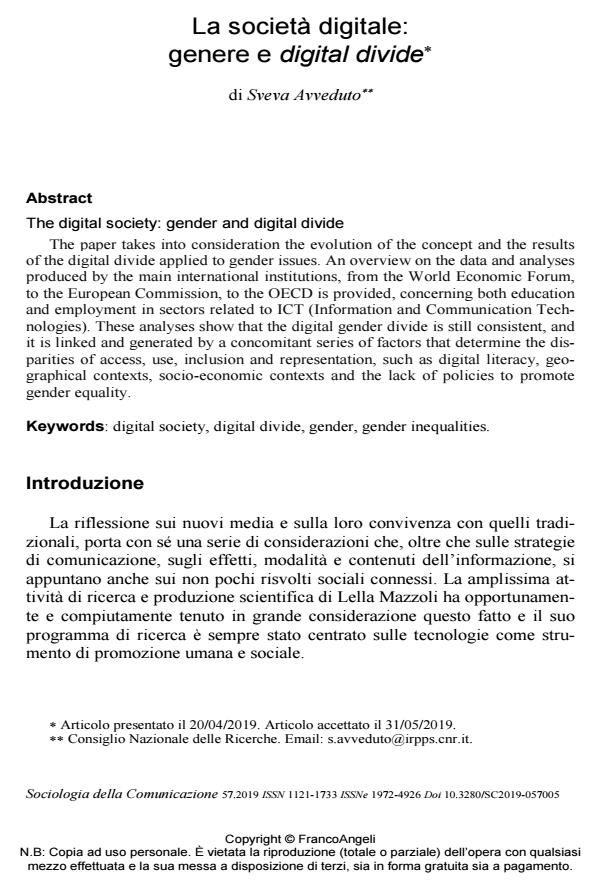La società digitale: genere e digital divide
Titolo Rivista SOCIOLOGIA DELLA COMUNICAZIONE
Autori/Curatori Sveva Avveduto
Anno di pubblicazione 2019 Fascicolo 2019/57 Lingua Italiano
Numero pagine 19 P. 65-83 Dimensione file 626 KB
DOI 10.3280/SC2019-057005
Il DOI è il codice a barre della proprietà intellettuale: per saperne di più
clicca qui
Qui sotto puoi vedere in anteprima la prima pagina di questo articolo.
Se questo articolo ti interessa, lo puoi acquistare (e scaricare in formato pdf) seguendo le facili indicazioni per acquistare il download credit. Acquista Download Credits per scaricare questo Articolo in formato PDF

FrancoAngeli è membro della Publishers International Linking Association, Inc (PILA)associazione indipendente e non profit per facilitare (attraverso i servizi tecnologici implementati da CrossRef.org) l’accesso degli studiosi ai contenuti digitali nelle pubblicazioni professionali e scientifiche
;
Keywords:Digital society, digital divide, gender, gender inequalities.
- Avveduto S. (a cura di) (2012), Scienza Connessa. Rete Media e Social Network, Gangemi Editore, Roma.
- Ching Yuen Luk (2019), A Human Rights-Based Approach to Bridge Gender Digital Divide: The Case Study of India, Nanyang Technological University, Singapore,
- European Commission (2005), EQUAL Guide on Gender Mainstreaming, Luxembourg: Office for Official Publications of the European Communities, ISBN 92-79-00128-0
- European Commission (2018), Women in the Digital Age, Final Report study prepared for the European Commission DG Communications Networks, Content & Technology by Iclaves, EU, ISBN: 978-92-79-77625-0 DOI: 10.2759/52693
- European Commission (2019) She Figures 2018 - Gender in Research and Innovation, Brussels
- European Parliament, Committee on Women’s Rights and Gender Equality (2016) Report on gender equality and empowering women in the digital age. DocRef(2015/2007(INI), <NoDocSe>A8-0048/2016</NoDocSe>
- Istat (2019) Report Cittadini Imprese e ICT, Istat, Roma
- Mariscal, Judith; Mayne, Gloria; Aneja, Urvashi; Sorgner, Alina (2019): Bridging the gender digital gap, Economics: The Open-Access, Open-Assessment E-Journal, ISSN 1864-6042, Kiel Institute for the World Economy (IfW), Kiel, Vol. 13, Iss. 2019-9, pp. 1-12,
- http://dx.doi.org/10.5018/economics-ejournal.ja.2019-9
- Mazzoli L. (2012) Miti, rischi e realtà del consumo delle news online, in S. Avveduto (a cura di), Scienza Connessa. Rete Media e Social Network, Gangemi Editore, Roma,
- Mazzoli L. (2013) Il consumo di informazione degli italiani: nuovi media, nuovi divide in “Sociologia del lavoro” n. 132, pp. 11-23.
- McKinsey (2015). The Power of Parity: How Advancing Women’s Equality can add $12 trillion to Global Growth. -- https://www.mckinsey.com/featured-insights/employment-and-growth/how-advancing-womens-equality-can-add-12-trillion-to-global-growth.
- Neerukonda, Mounika; Chaudhuri, Bidisha (2018) Are Technologies (Gender)-Neutral? Politics and Policies of Digital Technologies, “ASCI Journal of Management. Supplement”, Vol. 47, p. 32-44.
- OECD (2006) Women in Scientific Careers: Unleashing the Potential, Oecd, Paris
- OECD (2017a) Employment Outlook 2017, Oecd, Paris.
- OECD (2017b), Preventing Ageing Unequally, OECD Publishing, Paris, -- https://dx.doi.org/10.1787/9789264279087-en.
- OECD (2017c), OECD Science, Technology and Industry Scoreboard 2017: The Digital Transformation, OECD Publishing, Paris, -- https://dx.doi.org/10.1787/9789264268821-en.
- OECD (2018) Bridging the Digital Gender Divide, OECD, Paris.
- OECD (2019a), “ICT Access and Usage by Households and Individuals”, OECD Telecommunications and Internet Statistics (database), -- https://dx.doi.org/10.1787/b9823565-en (accesso 28 gennaio 2019).
- OECD (2019b), Enhancing Access and Connectivity to Harness Digital Transformation, OECD Going Digital Policy Note, OECD, Paris, -- www.oecd.org/going-digital/enhancing-access-digital-transformation.pdf.
- Orlikowski, Wanda J. (2000), Using Technology and Constituting Structures: A Practice Lens for Studying Technology in Organizations, “Organization Science” Vol. 11, No. 4.
- Shashi Bala, Puja Singhal, (2018), Gender digital divide in India: a case of inter-regional analysis of Uttar Pradesh, “Journal of Information, Communication and Ethics in Society”, Vol. 16 Issue: 2, pp. 173-192, -- https://doi.org/10.1108/JICES-07-2017-0046.
- Smith-Doerr, L., Alegria, S. N., & Sacco, T. (2017), How Diversity Matters in the US Science and Engineering Workforce: A Critical Review Considering Integration in Teams, Fields, and Organizational Contexts. 3, 15.
- UN (2015), Sustainable Development Goals, United Nations, New York. -- http://www.un.org/sustainabledevelopment/gender-equality/.
- Yonghong Xu (2015), Focusing on Women in STEM: A Longitudinal Examination of Gender-Based Earning Gap of College Graduates, “The Journal of Higher Education”, Volume 86, Number 4, July/August 2015, pp. 489-523.
- Wagg, S., Cooke, L.; Simeonova, B., (2019), Digital inclusion and women’s health and well-being in rural communities, in “Oxford Handbook of Digital Technology and Society”, Oxford University Press.
- World Economic Forum (2018), Global Gender Gap Report 2018 -- http://reports.weforum.org/global-gender-gap-report-2018/
- Digital divide, e-government and trust in public service: The key role of education Diego Mesa, in Frontiers in Sociology 1140416/2023
DOI: 10.3389/fsoc.2023.1140416
Sveva Avveduto, La società digitale: genere e digital divide in "SOCIOLOGIA DELLA COMUNICAZIONE " 57/2019, pp 65-83, DOI: 10.3280/SC2019-057005